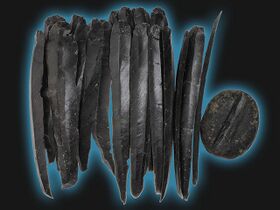Spektakulärer Obsidianfund erinnert auch an Fahrt der ABORA IV
(dg) Das Onlinemagazin ScinceXX veröffentlichte am 28.11.2023 einen Artikel zur prähistorischen Seefahrt. Darin schildern sie über einen spektakulären Obsidianfund bei Capri in Italien: „Archäologen haben vor Capri die mögliche Fracht eines jungsteinzeitlichen Schiffswracks entdeckt. Es handelt sich um mehrere Obsidianblöcke am Meeresgrund, die deutliche Bearbeitungsspuren aufweisen, wie sie für Rohlinge von Steinzeitwerkzeugen typisch sind. Die Archäologen vermuten, dass diese mehr als 5.000 Jahre alten Funde von einem prähistorischen Schiffswrack oder Floß stammen, das einst vor Capri sank“.
Dieser Fund erinnert auch die Fahrt der ABORA IV im Jahr 2019. Ihr letzter Törn von Santorin nach Kaş nahe Antalya führte auch entlang einer uralten Obsidian-Handelsroute. Türkische Archäologen hatten schon vor Jahren größere Mengen Obsidian nahe Patara gefunden, das sie auf ein Alter von über 9.000 Jahren datieren konnten. Mittels einer Bestimmungsmethode nach Collin Renfrew ließ sich das Material zur griechischen Insel Melos verorten. Dort war bereits am Ende des Paläolithikums ein Obsidian-Handelszentrum entstanden, das dieses Material sternförmig in alle Richtungen über die Ägäis exportierte.
Die ABORA IV segelte genau entlang einer dieser Handelsrouten und konnte demonstrieren, wie effizient damalige besegelte Schilfflöße gewesen waren. Die etwa 500 km lange Strecke legte das Floß in nur 6 Tagen zurück – und das bei sehr schwierigen Wetterbedingungen. Das nach jungsteinzeitlichen Quellen gebaute Schilfboot musste quer zum Wind und zur Strömung navigieren, um gezielt den Handelshafen im Südwesten der Türkei anzusteuern. Damit hatte die ABORA IV empirisch nachgewiesen, dass diese Wasserfahrzeuge schon vor der Bronzezeit den Obsidianhandel über weite Strecken des Mittelmeeres vermittelten.
Quelle: https://www.scinexx.de/news/archaeologie/steinzeit-schiffswrack-vor-capri-entdeckt/
Dieser Obsidianbrocken am Meeresgrund vor Capri stammt aus der Jungsteinzeit und könnte einst Fracht eines prähistorischen Boots oder Floßes gewesen sein. © SABAP 2023 //
This chunk of obsidian on the seabed off Capri dates back to the Neolithic period and may have once been the cargo of a prehistoric boat or raft. © SABAP 2023ABORA IV auf ihrer Seereise von Varna in Bulgarien vom Schwarzen Meer durch die gesamte Ägäis bis in den Südwesten der Türkei. In nur 19 Segeltagen legte sie mehr als 1.500 km zurück. Zudem erwies sie sich in den navigatorisch sehr anspruchsvollen Inselkanälen der Kykladen (Ägäis) als voll manövrierfähig und hochseetauglich. //
ABORA IV on her sea voyage from Varna in Bulgaria from the Black Sea through the entire Aegean to southwest Turkey. She covered more than 1,500 km in just 19 days of sailing. In addition, she proved to be fully maneuverable and ocean-going in the navigationally very demanding island channels of the Cyclades (Aegean).Das Schilfboot bestand auch schwierige Wettersituationen mit Meter hohen Wellen ohne die geringste Beanstandung. Dabei konnte sie mehrere Tonnen Fracht vom Schwarzen Meer bis an die lykische Küste sicher transportieren. //
The reed boat also endured difficult weather situations with meter-high waves without the slightest complaint. She was able to safely transport several tons of cargo from the Black Sea to the Lucian coast in just a few weeks.Obsidian war das “Eisen der Steinzeit” und ein begehrtes Material, das es nur an wenigen Orten im Mittelmeerraum vor allem auf Vulkaninseln gab. Aufgrund seiner Schärfe wurde es auch weit bis in die Bronzezeit hinein benutzt. Wichtige Quellen waren neben Melos auch die Liparischen Inseln, Sardinien oder Pantelleria. //
Obsidian was the “iron of the Stone Age” and a sought-after material that was only available in a few places in the Mediterranean, especially on volcanic islands. Because of its sharpness, it was used well into the Bronze Age. In addition to Melos, important sources were also the Aeolian Islands, Sardinia and Pantelleria.Henry Tzalas testete schon 1988 ein prähistorisches Schilffloß auf einer experimentellen Reise von der griechischen Insel Melos zum Festland. Die "Papyrella" bestand den Test erfolgreich und untermauerte damals, dass die Handelsfahrten auch mit scheinbar primitiven Schilfbooten möglich waren.//
Back in 1988, Henry Tzalas tested a prehistoric reed raft on an experimental trip from the Greek island of Melos to the mainland. The "Papyrella" passed the test successfully and confirmed at the time that trading trips were also possible with seemingly primitive reed boats.
Spectacular obsidian discovery also reminds us of the voyage of the ABORA IV
The online magazine ScinceXX published an article on prehistoric seafaring on November 28, 2023. In it they describe a spectacular obsidian discovery near Capri, Italy: “Archaeologists have discovered the possible cargo of a Neolithic shipwreck off Capri. These are several blocks of obsidian on the seabed that show clear traces of processing, typical of the blanks of Stone Age tools. Archaeologists suspect that these finds, which are more than 5,000 years old, come from a prehistoric shipwreck or raft that once sank off Capri.
This find also commemorates the voyage of the ABORA IV in 2019. Her last trip from Santorini to Kas near Antalya also led along an ancient obsidian trade route. Years ago, Turkish archaeologists had found large quantities of obsidian near Patara, which they were able to date to be over 11,000 years old. Using an identification method according to Collin Renfrew, the material was located on the Greek island of Melos. An obsidian trading center had already emerged there at the end of the Paleolithic, exporting this material in a star shape in all directions across the Aegean.
The ABORA IV sailed precisely along these trade routes, and was able to demonstrate how efficient sailed reed rafts of the time had been. The raft covered the approximately 500 km long route in just 6 days - in very difficult weather conditions. The reed boat, built according to Neolithic sources, had to navigate across the wind and current in order to head specifically for the trading port in southwest Turkey. The ABORA IV had thus empirically proven that these watercrafts were able to broker trade over long distances of the Mediterranean even before the Bronze Age.
Source: https://www.scinexx.de/news/archaeologie/steinzeit-schiffswrack-vor-capri-entdeckt/




